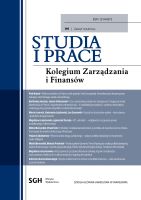Wykorzystanie Dynamic Time Warping do analizy polityki pieniężnej, sektora finansowego i wzrostu gospodarczego Polski oraz wybranych krajów Europy Środkowo-Wschodniej
Utilising Dynamic Time Warping to analyse the monetary policy, financial sector, and economic growth of Poland and selected countries of Central and Eastern Europe
Author(s): Michał Bernardelli, Mariusz PróchniakSubject(s): Economic policy, Economic development, Fiscal Politics / Budgeting, Socio-Economic Research
Published by: Szkoła Główna Handlowa w Warszawie
Keywords: monetary policy; financial sector; economic growth; dynamic time warping; similarities of time series;
Summary/Abstract: The aim of this study is to examine the impact of the monetary policy (and, more broadly, the financial sector) on the real economy in selected European countries, taking into account their fiscal policy as well. The study includes 15 European countries that are not part of the eurozone and covers the period of 2010–2022. In the analysis, we utilise the Dynamic Time Warping (DTW) method, which is an innovative method for comparing time series, particularly novel in the fields of economics and finance. We compare the countries based on five variables: interest rates, the money supply growth rate, the state consumption expenditure growth rate, the economic growth rate, and the inflation rate. The results show that based on the variables representing the monetary policy (interest rates and money supply dynamics), two clusters of countries with similar monetary policy approaches can be identified. The study provides several recommendations for economic policy, particularly in the field of monetary policy.
Journal: Studia i Prace Kolegium Zarządzania i Finansów
- Issue Year: 2023
- Issue No: 191
- Page Range: 101-122
- Page Count: 22
- Language: Polish

